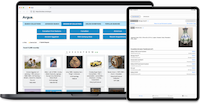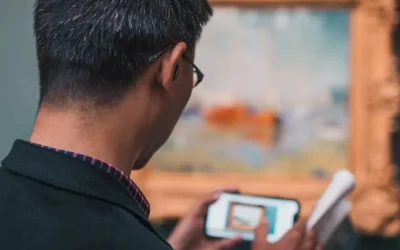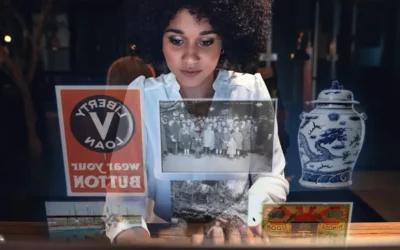Considering AI as an Empathy Generator in Museum Spaces

Rachael Cristine Woody
However, the efficacy of empathy generation depends on how impactful the connection experience was. There are a number of levers we could pull in order to increase efficacy; these include how engaging the exhibit is—as well as how memorable. On the face of it, Artificial Intelligence (AI) may seem like just technology, but humans are purposefully teaching AI to recognize, interpret, and predict human thought and behavior. In other words, we’re building AI in our image. As such, I’m suggesting we can use Generative Artificial Intelligence (GenAI) to serve as an empathy generator in the museum space.
Generating Empathy in Museums in a Whole New Way
In January 2024, Museum Forecast 2024 was published and it included my forecast for “AI: Artificial Intelligence as Empathy Generators in Museums.” In the forecast, I mention The Future of Museums Summit by AAM’s The Center for the Future of Museums, and a session titled “Putting AI to Work in the Museum,” with panelist Beth Harrison, Director of Digital Experiences at the The Dalí. The Dalí fed a GenAI tool images, letters, and other text about Salvador Dalí so that the tool could create a dynamic and interactable Dalí via a full-sized screen.
The Dalí Experience
To see the technology in action, please check out Dezeen’s Museum created deepfake Salvador Dalí to greet visitors, a video:
The following is a description I wrote for the forecast post that describes the AI-Dalí experience:
When you first approach Dalí you see him in the distance (in the screen) with a spotlight on him painting. Then, his body stiffens and after a moment he turns his head because he “felt” your presence. His face then transforms to delight at seeing you and quickly gets up and walks over to you (the front of the screen). You can ask him any question you want and he’ll answer you based on the thousands of pieces of data he has access to. This makes his responses feel genuine and natural, not robotic or pre-programmed at all. While Dalí’s known eccentricities can be charming, what seals the deal is the end of the interaction. Toward the end of your conversation with Dalí, he asks you if he can take a selfie with you. If you agree, he holds up a smart phone on his side (in the screen) and you all pose together. This image is then texted to you as a memento. You may think this modern action pokes a hole in the historical accuracy of it all, but its end effect is endearing and inspires a sense of connectedness.
ExploreAIHub
Another stunning example of GenAI applied to art was created by ExploreAIHub using China’s AI video model: Kling AI.
This example features the following paintings:
- Las Meninas, Diego Velázquez
- Young Woman at the Window, Salvador Dalí
- El Quitasol, Francisco de Goya
- La Maja Vestida, Francisco de Goya
- Two Women at the Window, Bartolomé Esteban
- Old Woman Cooking Eggs, Diego Velzáquez
- The Nobleman with his Hand on his Chest, El Greco
Each of these begin as paintings and then shift into a seemingly real scene where the people move and express emotion. These paintings of real people become real again. In fact, the realism with which GenAI tools can now conjure movement from still images is so believable that it’s completely captivating. I’ve watched this video at least a dozen times. The impact of these experiences is at a high efficacy rate and so memorable that I still think about the Dalí experience 10 months later
What Does GenAI Mean for the Future of Museums?
The near future of GenAI in museums will enrich museum audience experiences, make some aspects of our jobs easier, serve as a partner is collection management work, increase the intuitiveness for searching our collections, and enhance the museum’s ability to inspire empathy in our visitors. We can aid in the learning process and increase the potential of GenAI efficacy by experimenting with it. GenAI is another tool in the toolbox and there are great opportunities ahead.
Additional Reading

Rachael Cristine Woody
Energized by this post? Please join us for the companion webinar Museum Collections Online and the Potential of AI, TODAY September 25, 2024 at 11 a.m. Pacific, 2 p.m. Eastern. (Can’t make it? Register anyway and we will send you a link to the recording and slides afterwards). Register now or call 604-278-6717.
**Disclaimer: Any in-line promotional text does not imply Lucidea product endorsement by the author of this post.
Never miss another post. Subscribe today!
Similar Posts
Storytelling to Inspire Reflection Using Museum Collections Online
Storytelling with online collections is impactful, whether we choose online-only or as part of a hybrid approach to museum exhibitions.
Museum Collections Online: Learning Through Storytelling
Digitizing museum collections introduces new and engaging opportunities for storytelling. By leveraging digital surrogates—essentially online representations of physical objects—museums can enhance how they present narratives and information to audiences.
The Role of Museum Collections Online in Storytelling & Audience Engagement
Storytelling with museum collections online allows for a great degree of flexibility, offers additional detail, and lends a dynamism that is difficult to produce within a physical exhibition.
Examples of How Archives Can Be Used to Elevate Museum Collections
Last week we reviewed how archives can enhance museum collections online. This week will continue our work with an examination of specific examples, including what items different types of archives may contain and where to capture this data.





Leave a Comment
Comments are reviewed and must adhere to our comments policy.
0 Comments